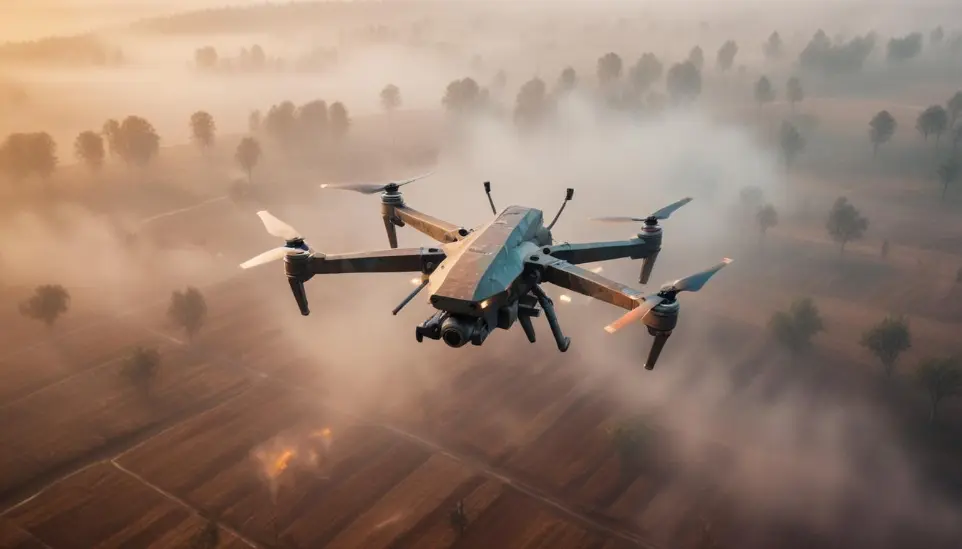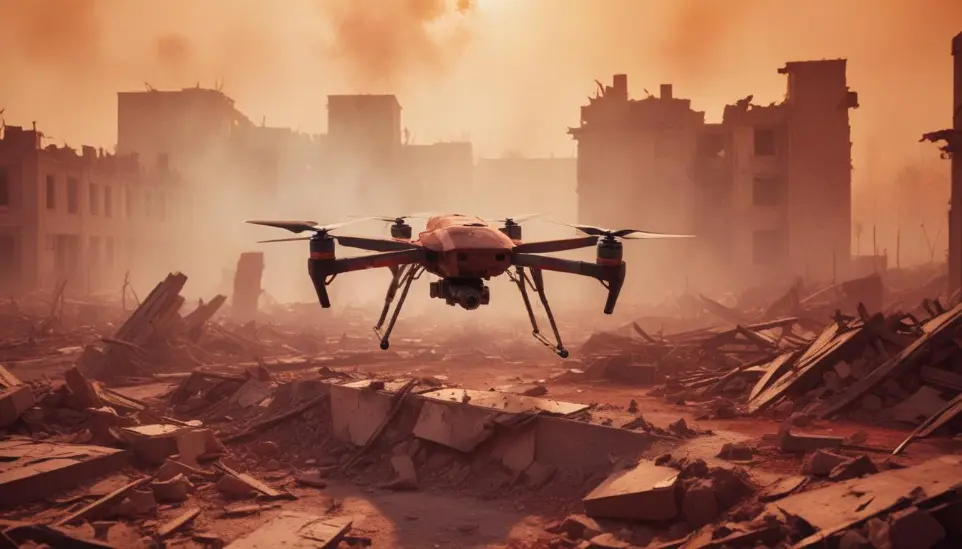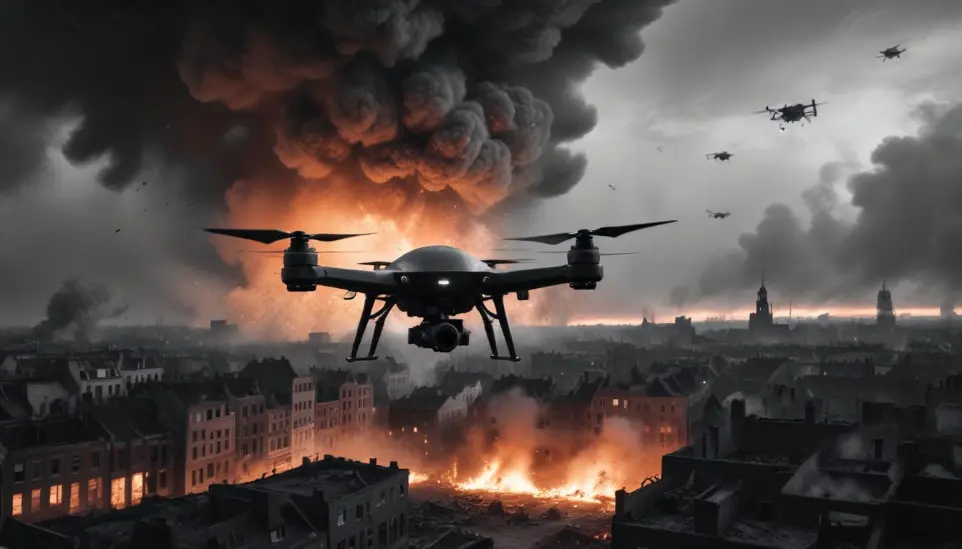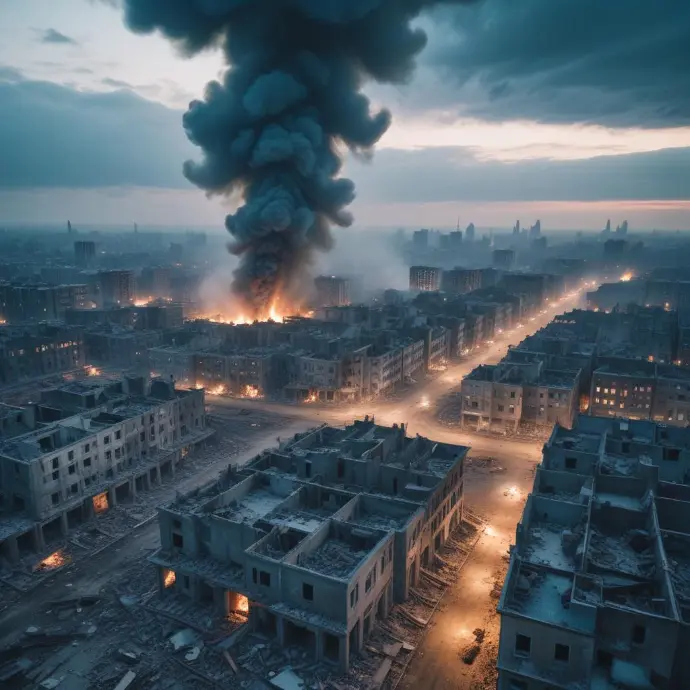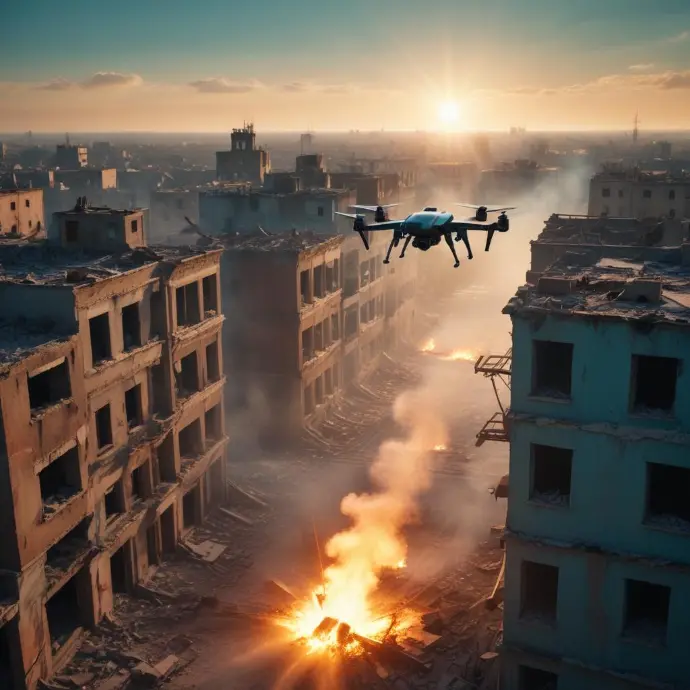In our feature article, "The Use of Drones and AI in War Conflicts: Human Rights Implications," we will thoroughly explore the ethical and legal implications of using drones in armed conflicts. How does this technology affect the protection of human rights? What are the implications of artificial intelligence in this context? Prepare for a fascinating journey through the intersection of human rights and technology. Ahead, delve into the world of human rights advocacy and discover how technology is shaping the field.
Introduction
Drones, also known as unmanned aerial vehicles (UAVs), are remotely or autonomously controlled aircraft. These devices have evolved significantly in recent years, moving from being used primarily for military purposes to civilian applications in fields such as agriculture, security, logistics, and cinematography.
On the other hand, artificial intelligence (AI) refers to the ability of machines to learn, reason, make decisions, and perform tasks autonomously, simulating human intelligence. In the context of drones, AI is used to automate navigation, target identification, decision-making, and real-time data analysis.
The combination of drones and AI has led to significant advances in fields such as surveillance, assistance in rescue operations, and the implementation of military strategies, but it also poses ethical and legal challenges, especially in the context of armed conflicts.
War conflicts, both national and international, have been a constant throughout history. These conflicts often involve acts of violence, destruction, and human rights violations, affecting civilian populations and generating devastating humanitarian and social consequences.
Currently, war conflicts have been influenced by technological advancements, with the use of increasingly sophisticated weapons and the integration of technologies such as drones and artificial intelligence into military strategies. This technological evolution poses new challenges in terms of human rights protection, as the consequences of their application in conflict contexts can be devastating for the civilian population and fundamental rights.
The proliferation of weapons based on drone technology and the integration of artificial intelligence systems into military operations have raised concerns about the impact on the protection of human rights in situations of armed conflict.
The use of drones and artificial intelligence systems in armed conflicts poses significant challenges regarding the respect and protection of human rights. Drones' ability to carry out surveillance, target identification, and remote attacks, combined with the autonomy of artificial intelligence in decision-making, raises ethical and legal questions about accountability, transparency, and oversight in the use of these technologies in contexts of armed conflict.
The lack of clarity surrounding international norms and regulations governing the use of drones and artificial intelligence in conflict situations, coupled with the difficulty in attributing responsibility for human rights violations, creates a complex scenario in which the protection of civilians is threatened.
It is crucial to comprehensively address the ethical, legal, and humanitarian implications of the use of drones and artificial intelligence in armed conflicts in order to ensure respect for human rights and prevent unnecessary suffering of civilians in conflict zones.las necesidades únicas de empresas en varios sectores para ayudarles a crecer y tener éxito en un mercado competitivo.
The Use of Drones in War Conflicts
In recent history, the use of drones in armed conflicts has experienced exponential growth. Drones, also known as Unmanned Aerial Vehicles (UAVs), have evolved from simple surveillance tools to lethal weapons used in military operations. Their development has been largely driven by advances in artificial intelligence (AI) technology and the miniaturization of electronic components.
The evolution of drones has been significant, evolving from aerial surveillance devices to lethal weapons capable of launching precise missile or bomb attacks. This change has completely transformed the way armed conflicts are conducted, allowing the actors involved to carry out military operations with less risk to their own personnel, but with significant implications for the protection of human rights.
The use of drones in armed conflicts has sparked intense debate in the international community due to the ethical and legal implications it entails. The ability of drones to carry out targeted attacks has raised questions about their impact on the protection of human rights, particularly with regard to the distinction between combatants and civilians, and respect for international humanitarian law.
The impact of drone use on human rights is a highly relevant issue today. While proponents of this technology argue that it allows for more precise military operations and less risk to personnel, numerous cases have also been documented in which drone attacks have caused civilian casualties. The lack of clarity surrounding the responsibility and accountability of drone operators, as well as the lack of transparency surrounding the criteria used to carry out attacks, raises serious concerns regarding respect for human rights.
The use of drones in armed conflicts has also raised concerns regarding the privacy and safety of civilian populations. Drones' ability to conduct discreet and prolonged aerial surveillance poses challenges in terms of the protection of personal data and individual freedoms, which can have a significant impact on the daily lives of people living in areas affected by armed conflict.
The use of drones in armed conflicts poses substantial challenges regarding the protection of human rights, both in terms of conduct during military operations and in relation to the privacy and security of affected civilian populations.
Faced with growing concerns about the use of drones in armed conflicts, the international community has sought to establish regulations governing their use in the military sphere. However, the transnational nature of this technology and the difficulty in attributing responsibility in cases of drone attacks have complicated the development of effective regulatory frameworks.
Currently, there are international regulations that prohibit the use of indiscriminate or disproportionate weapons, regardless of the platform from which they are launched, including drones. However, the applicability of these regulations in practice and the need to adapt them to the specificities of drones as an attack platform continue to be the subject of debate and negotiation among States.
In this regard, the need to establish clear standards and effective accountability mechanisms regarding the use of drones in armed conflict is an urgent challenge facing the international community today. The protection of human rights in the context of the technological evolution of drones and AI represents a key area of interest for human rights defenders globally.
The use of drones in armed conflicts has generated a number of challenges and controversies related to human rights. One of the main challenges is the lack of transparency and accountability in drone operations, which makes it difficult to assess their compliance with international humanitarian law. Furthermore, the ability of drones to carry out targeted attacks has raised questions about the distinction between combatants and civilians, which can lead to violations of the right to life and the right to protection from indiscriminate attacks.
Another point of controversy is the psychological and emotional impact on civilian populations living under the constant presence of drones. Drone surveillance and attacks can generate a climate of fear and anxiety in affected communities, affecting their psychological and emotional well-being. Furthermore, the lack of clarity surrounding drone use policies and the possibility of errors in target identification raise concerns about violations of people's right to privacy and security in conflict zones.
Furthermore, the proliferation of non-state-made and operated drones has raised concerns about the possibility of these non-state actors conducting drone operations indiscriminately and without following the norms and protocols established in international humanitarian law. This situation poses additional challenges for the protection of human rights in contexts of armed conflict, as the lack of regulation and oversight can increase the risk of abuses and violations of fundamental rights.
AI in Warfare
Artificial Intelligence (AI) has become an increasingly relevant tool in the military, with applications ranging from pattern recognition in satellite imagery to real-time strategic decision-making. In the case of drones, AI is used to improve the accuracy of attacks, identify targets more efficiently, and minimize risk to military personnel.
In addition, AI is also used in the collection and analysis of large volumes of data, allowing actors in conflict to obtain detailed information about the terrain, enemy movements, and changing battlefield conditions. These capabilities provide a significant strategic advantage to those with access to this technology.
AI is used in warfare to optimize decision-making, increase the accuracy and effectiveness of attacks, and gather strategic information more quickly and in greater detail.
The use of AI in warfare raises several ethical and legal challenges. First, the question of accountability and autonomous decision-making by AI systems raises concerns about who bears responsibility for the actions taken by these systems. Furthermore, the possibility of autonomous attacks raises questions about the ethics of warfare and respect for international norms in armed conflict.
From a legal perspective, the use of AI in warfare raises the need to review and update international laws and conventions to address the specific challenges posed by this technology. This includes the need to establish clear protocols for the development and use of AI systems in the military context, as well as to ensure accountability and transparency in their implementation.
The ethical and legal implications of the use of AI in warfare require detailed analysis and concerted international action to ensure that the use of this technology complies with the ethical and legal principles governing warfare and respect for human rights.
Currently, there have been significant developments in the use of AI in warfare, with a particular focus on autonomy and decision-making by autonomous systems. This has generated debate and concerns about the possibility of an "arms race" in the development and deployment of AI systems in the military.
Furthermore, progress has been made in integrating AI with other technologies, such as facial recognition and mass surveillance, raising additional concerns regarding privacy, civil liberties, and human rights. These recent developments underscore the importance of proactively and collaboratively addressing the implications of AI in warfare, both nationally and internationally.
Recent developments in the use of AI in warfare require careful attention and a thorough assessment of their ethical, legal, and humanitarian implications to ensure their implementation is carried out responsibly and in accordance with fundamental human rights principles.
Impact on Human Rights
The use of drones and artificial intelligence (AI) in war conflicts has raised serious concerns regarding respect for human rights. Drones' ability to carry out targeted attacks has generated controversy, as while they can reduce the risk to military personnel, they can also increase the risk to civilians. Furthermore, AI technology applied to real-time decision-making raises ethical questions about responsibility for actions taken, as well as transparency and accountability.
Furthermore, the use of drones in surveillance operations also raises concerns regarding the right to privacy, as they can carry out indiscriminate surveillance that affects the daily lives of people in conflict zones. This can create a climate of fear and mistrust, in addition to limiting individuals' freedom of movement and privacy.
The use of drones and AI in armed conflict has led to human rights violations, raising ethical, legal, and operational challenges that require careful and urgent attention.
Given the human rights implications of the use of drones and AI in armed conflict, it is crucial to consider measures to protect civilians and ensure compliance with international standards. One key measure is strengthening transparency and accountability in military operations involving drones and AI technology, ensuring that decisions and actions are adequately reviewed and monitored.
Furthermore, it is essential to establish clear protocols for the collection, storage, and use of data obtained through drone surveillance in order to protect individuals' right to privacy. Likewise, the development of legal and ethical frameworks regulating the use of AI in war contexts must be promoted, ensuring that the principles of proportionality, distinction, and precaution in the use of force are respected.
Ultimately, the implementation of effective safeguards and the promotion of inclusive and transparent dialogue are essential elements for protecting human rights in the context of military technology, ensuring that the fundamental principles of dignity, liberty, and security are respected for all people affected by conflict.
The impact of the use of drones and AI in war conflicts is not limited to a specific geographical area but has global repercussions for respect for human rights. The proliferation of this technology poses challenges for the international community in terms of regulation and oversight, given that its use transcends national borders and can affect populations in different countries.
Furthermore, the development and deployment of drones and AI systems in warfare can set precedents for the use of technology in other contexts, highlighting the importance of comprehensively addressing the ethical, legal, and humanitarian implications of these practices. Likewise, decisions made regarding the use of drones and AI in warfare can influence the perception and respect for human rights in other conflict situations, setting standards and precedents that will impact the protection of fundamental rights globally.
The global impact of the use of drones and AI in warfare requires a collaborative and coordinated approach by the international community to ensure that human rights are protected in all contexts and that the ethical and responsible use of technology is promoted for the sake of international peace and security.
Conclusions
The use of drones and artificial intelligence in war conflicts raises ethical and legal dilemmas that must be urgently addressed. While these technologies offer advantages in terms of precision and reducing civilian casualties, they also pose significant risks to human rights. It is essential that the international community establish clear protocols to regulate the use of drones and artificial intelligence in conflict situations, in order to safeguard the lives and dignity of those affected.
Furthermore, it is crucial that thorough research be conducted on the impact of these technologies on human rights, in order to fully understand their implications and take appropriate measures to mitigate any potential harm. Transparency and accountability for those involved in the development and use of drones and artificial intelligence are essential to ensuring respect for human rights in conflict settings.
Ultimately, the use of drones and artificial intelligence in armed conflict must be approached with the utmost seriousness and responsibility, considering not only the tactical and strategic implications but also the humanitarian and ethical impact of these technologies.
Future challenges regarding the use of drones and artificial intelligence in armed conflict are significant. One of the main challenges lies in the need to develop effective international regulatory frameworks that ensure the ethical and legal use of these technologies, as well as accountability in the event of abuse.
Furthermore, it is critical to promote transparency in the research and development of drones and artificial intelligence, in order to identify and address potential human rights risks from the earliest stages of their implementation. Human rights organizations, governments, and civil society must work closely together to monitor and evaluate the impact of these technologies and advocate for their responsible and ethical use.
In this regard, it is recommended that concerted efforts be made to raise public awareness about the implications of drones and artificial intelligence in armed conflicts, in order to foster informed debate and the adoption of concrete measures to protect human rights in armed conflict settings.

 IHRO NEWS
IHRO NEWS